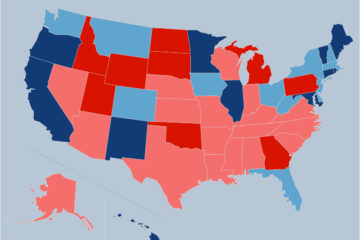
Certain State Policies Are Linked to Better Health, Fewer Premature Deaths Among Working-Age Americans
Explore which state policies are tied to longer lives and fewer deaths from overdoses, alcohol abuse, and suicide
Date
April 12, 2023
Focus Area
State policies are making a dramatic difference in how long working-age Americans live, contributing to the so-called deaths of despair from overdose, alcohol abuse, and suicide, new research shows.1
Over the 20-year span from 1999 to 2019, more conservative marijuana policies and more liberal policies on the environment, gun safety, labor rights, economic taxes, and tobacco taxes were tied to fewer premature deaths and better health among Americans ages 25 to 64, analysis by Jennifer Karas Montez at Syracuse University and colleagues shows (see Table).2
Table. State Policies Associated With Longer Life Expectancy, Fewer Deaths, and Better Overall Health Among Working-Age U.S. Adults
Types of State Policies Associated With Lower Mortality and Better Health Among U.S. Adults Ages 25 to 64, Between 1999 and 2019
(Higher) Sales Tax
(Greater) Top Capital Gains Rate
(Greater) Top Income Rate
(Higher) Corporate Tax Rate
Earned Income Tax Credit
(Higher) Estate Tax
(Higher) Income Tax
(Greater) Tax Burden
Bottle Bill
California Car Emissions Standards
Endangered Species
E-waste
Greenhouse Gas (GHG) Cap
Renewables Fund
Solar Tax Credit
State NEPA
Determinate Sentencing
Three Strikes
Death Penalty Repeal
DNA Motions
Truth-in-Sentencing
Open Carry
Stand Your Ground
Assault Weapon Ban
Background Checks for Dealer Sales
Background Checks for Private Sales
Brady Law
Dealer Licenses Required
Gun Registration
Saturday Night Special Ban
Welfare Drug Test
(Stricter) Welfare Time Limit
Affordable Care Act (ACA) Exchange
(Greater) AFDC Payment Level
AFDC Up
(Greater) CHIP Eligibility for Children
(Greater) CHIP Eligibility for Infants
(Greater) CHIP Eligibility for Pregnant Women
Expanded Dependent Coverage
Medicaid Adoption
Medicaid Expansion
Pre- Balanced Budget Act CHIP Eligibility
Senior Prescription Drugs
(Greater) TANF Eligibility
(Greater) TANF Payment Level
Local Minimum Wage Ban
Local Sick Leave Law Ban
Right to Work Law
(Greater) Disability Insurance
(Higher) Minimum Wage
Paid Family Leave
Paid Sick Leave
(Higher) Prevailing Wage
(Greater) Unemployment Compensation
Marijuana Decriminalization
Medical Marijuana
State Tax on a Pack of Cigarettes
English Official Language
E-Verify
Drivers Licenses for Undocumented
E-Verify Ban
In-State Tuition for Undocumented
State Cash Benefits for Recent Immigrants
State Food Benefits for Recent Immigrants
State Health Benefits for Recent Immigrants
Bible Allowed in Public Schools
Moment of Silence in Public Schools
Religious Freedom Rights Amendment
Corporal Punishment Ban
Discrimination Ban on Public Accommodations
Equal Rights Amendment (ERA) Ratification
Fair Employment Commission
Gender Discrimination Ban
Gender Equal Pay Law
No Fault Divorce
Physician-Assisted Suicide
Public Breast Feeding
Reporters Right to Source Confidentiality
State Americans With Disabilities Act (ADA)
State Era
Abortion Insurance Restriction
Consent Post-Casey
Consent Pre-Casey
(Stricter) Gestation Limit
Parental Notice
Partial Birth Abortion Ban
Physician Required
Waiting Required
Abortion Legal
Emergency Contraception
Medicaid Covers Abortion
Corporate Contribution Ban
Limit on Individual Contributions
Dollar Limit on Individual Contributions ($)
Limit on PAC Contributions (Yes, No)
Dollar Limit on PAC Contributions ($)
Public Funding Elections
CHARTER SCHOOL LAW
SCHOOL CHOICE
(Greater) Spending on Higher Education
(Greater) K-12 Spending
Gay Marriage Ban
Sodomy Ban
Civil Unions and Marriage
Hate Crime Law
LGB Discrimination Ban Public Accommodations
LGB Employment Discrimination Ban
Ban on Agency Fees for States
Collective Bargaining for Firefighters
Collective Bargaining for Local Employees
Collective Bargaining for Police
Collective Bargaining for State Employees
Collective Bargaining for Teachers
Absentee Voting
Early Voting
Motor Voter
Voter Identification
Rent Control Ban
Tort Limit
Growth Management
Lemon Law
Source: Jennifer Karas Montez et al., “U.S. State Policies, Politics, and Life Expectancy,” The Milbank Quarterly 98, no. 3 (2020): 668-99; Jennifer Karas Montez et al., “U.S. State Policy Contexts and Mortality of Working-Age Adults,” PLOS One, 17, no. 10 (2022); Jacob M. Grumbach, “From Backwaters to Major Policymakers: Policy Polarization in the States, 1970-2014,” Perspectives on Politics 16, no. 2 (2018): 416-35; and Blakelee Kemp, Jacob M. Grumbach, and Jennifer Karas Montez, “State Policy Contexts and Physical Health Among Midlife Adults” Socius: Sociological Research for a Dynamic World 8 (2022): 1-14.
Note: A liberal policy was defined as expanding state power for economic regulation and redistribution or for protecting marginalized groups or restricting state power for punishing deviant social behavior; a conservative policy was defined as the opposite. For example, a high minimum wage would be categorized as a liberal policy, while low corporate taxes would be conservative.
Lack of State Investment in Residents Tied to Death Rate Increase
Death rates among working-age Americans increased 6% between 2010 and 2017. Meanwhile, death rates for infants and adults ages 65 and older fell and rates for children were unchanged, according to Montez. A spike in drug- and alcohol-related deaths and suicides during this period played a key role, she reports.
“The rise in deaths among Americans in the prime of their lives has been particularly alarming over the last decade. And it’s a major reason why overall life expectancy in the United States stopped increasing around 2010 and started to decline around 2014,” says Montez, who directs the Center for Aging and Policy Studies at Syracuse University.
“While some states have invested in their populations’ well-being—for example, raising the minimum wage, implementing an EITC [earned income tax credit], expanding Medicaid, enacting clean indoor air laws—other states have either not invested or even divested,” she says. “It’s this latter group of states where the lives of working-age adults are being cut particularly short.”
The research team analyzed data from 1999 to 2019. They combined mortality information from the National Vital Statistics System and annual data on 135 state-level policies scored on a liberal to conservative scale and grouped into policy domains including gun safety, the environment, labor, and tobacco.
The link between policies and mortality rates is straightforward in some cases, but less clear in others, the study authors caution.
Marijuana restrictions were the only conservative policies strongly associated with lower mortality, specifically from suicide and alcohol-related causes, the study found. According to Montez, marijuana can provide pain relief but has also been linked to an increased risk of developing problem drinking, depressive disorders, and schizophrenia, as well as a higher risk of motor vehicle accidents and suicide.
Overall, the study found that liberal policies in many domains were associated with lower mortality, Montez says.
“More firearm safety policies are strongly connected to men’s suicide risk, with more liberal policies predicting smaller suicide risk,” Montez says. “Tobacco taxes were linked to a lower risk of cardiovascular disease. Evidence shows they deter smoking.”
The U.S. Centers for Disease Control and Prevention report smoking causes one in four deaths from cardiovascular disease.3
Labor policies such as raising the minimum wage and mandating paid leave were strongly connected to fewer alcohol-induced causes of death and suicides among men, the analysis shows.
“Labor policies can help prevent economic hardship, allow workers to take time off when they are sick or need to care for loved ones without fear of losing their jobs or income, reduce stress, and prevent stress-related coping behaviors such as smoking and heavy alcohol consumption,” Montez adds.
“These findings provide new insights into which policy domains appear most important for health,” she says, “and they largely concur with existing evidence on the effects of specific policies on health.”
For example, the finding that policies in the labor domain are a strong predictor of working-age mortality concurs with other evidence that specific policies within that domain, like higher minimum wages and paid leave, reduce working-age mortality risk, she says.
The one discrepancy was the health and welfare policy domain, according to Montez. Although their analysis found that the domain was not associated with mortality, other evidence has shown that specific policies within that domain, like Medicaid, reduce mortality.
Policy Choices—Not Differences in the Characteristics of State Residents—Are Driving Lifespan Gaps
Death rates among working-age people have widened among states in recent decades, with the death rate nearly twice as high in West Virginia as in Minnesota. But these differences cannot be fully explained by the proportion of college-educated or higher-income residents or even by rising deaths of despair, Montez asserts.
“A major driver of these differences is policy choices,” she says. “Other scientists have reached a similar conclusion.”
She points to a study by Benjamin Couillard at the Federal Reserve Bank of Boston and colleagues who tested several explanations for the growing differences in working-age deaths between states.4
The research team documents that changes in states’ populations related to race, educational attainment, and income inequality have not played a major role in mortality patterns. Instead, they show that growing differences in working-age deaths between states are due to major shifts in state policies in recent decades.
“These [policy] decisions have had life and death consequences,” Montez says.
This research was supported by the National Institute on Aging and conducted by a team of researchers including Jason Beckfield, Harvard University; Derek Chapman, Virginia Commonwealth University; Jacob M. Grumbach, University of Washington; Mark D. Hayward, University of Texas at Austin; Nader Mehri, Syracuse University; Shannon M. Monnat, Syracuse University; Steven H. Woolf, Virginia Commonwealth University; and Anna Zajacova, University of Western Ontario.
Christopher Munoz, Syracuse University, contributed to this report.
References
1Jennifer Karas Montez et al., “U.S. State Policy Contexts and Mortality of Working-Age Adults,” PLOS One, 17, no. 10 (2022).
2Montez et al., “U.S. State Policy Contexts and Mortality of Working-Age Adults.”
3Montez et al., “Smoking and Cardiovascular Disease.
4Montez et al., “Rising Geographic Disparities in US Mortality,” Journal of Economic Perspectives 35, no. 4 (2021): 123-46.



